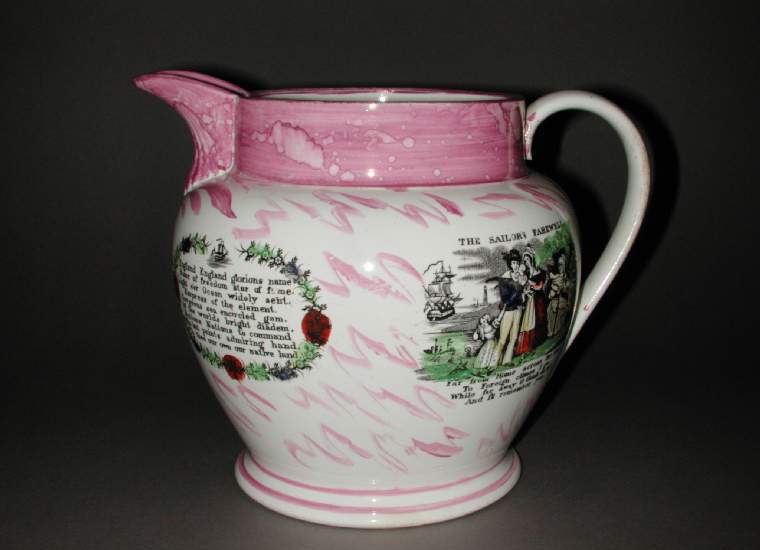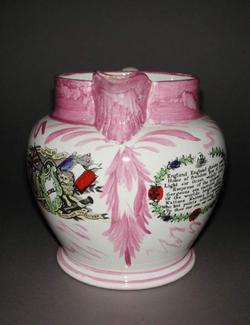Current Location: Gallery 27 (Glaisher)
Titles
'Sailor's Return' Jug
Maker(s)
Factory:
Scott Brothers & Co
(Possibly)
Scott's Southwick Pottery
((alternative name))
Entities
Categories
Description
White earthenware, transfer-printed in black with text and images, and painted with enamels and pink lustre.
Ovoid body tapering slightly to a projecting foot, with cylindrical neck, curved spout and loop handle. Decorated on the body with four transfer-prints over-painted with enamels. The rim is coated with mottled pink lustre and there are squiggles of pink lustre on the body, between the transfers. There are two pink lustre bands round the foot and a pink line runs down the back of the handle. The underside is flat and glazed, with a raised foot-rim.
The images and text are as follows:
(i)To left of handle: 'THE SAILOR'S FAREWELL', above an image of same with a ship in the background, above verse: 'Far from Home across the Sea/To Foreign climes I go./While far away O think on me/And I'll remember you'.
(ii)To right of handle: 'THE SAILOR'S RETURN', above an image of same with ship, above verse: 'Now safe returned from dangers past/With joy I hail the shore./And fear no more the tempests blast/Nor Oceans angry roar.'
(iii) Under the spout, to the left: a trophy with a lion, an eagle, the Union Jack, the French flag, a shield inscribed 'CRIMEA', and the words, 'MAY THEY EVER BE UNITED. VIVe L'EMPREUR GOD SAVE THE QUEEN'.
(iv) Under the spout to the right, in a wreath, the lines: 'England, England, the glorious name/Home of freedom star of fame/Light o'er Ocean widely sent/Empress of the element/Gorgeous sea encircled gem/Of the world's bright diadem/ Nations nations to command/Who but points admiring hand/To thee our own our native land'.
Notes
History note: Billson collection until 1908. Sold at Sotheby’s 21 December 1908 with two other Sunderland jugs, lot 120, for 10 shillings. Bought by Mr S. Fenton for Dr Glaisher, Trinity College, Cambridge.
Legal notes
Dr J.W.L. Glaisher Bequest
Measurements and weight
Height: 22 cm
Width: 27.5 cm
Acquisition and important dates
Method of acquisition: Bequeathed
(1928)
by
Glaisher, J. W. L., Dr
Dating
19th Century, Mid
Victoria I
Crimean War
Circa
1854
CE
-
Circa
1856
CE
Note
Images of ‘the Sailor’s Farewell and Happy Return’, popular from the mid-18th Century in engravings or on ceramic plaques as well as on jugs and bowls, were used as a mark of patriotism during the Crimean War. A contemporary account records that ‘The Sailor’s Farewell’, hung on the wall when the sailor left shore, would be swapped for ‘Return’ when he came safely home.
Sunderland potteries were particularly known for their use of thinly hand-painted lustre, together with hand-painted transfer-prints which feature designs, verses and mottos. The designs usually have local or topical relevance and often allude to seafaring. Scott Brothers (also known as Scott’s Pottery), founded in 1788, was one of the most important Sunderland producers of lustre transfer-print designs and had a substantial export market as well as domestic customers.
The ‘Crimea’ transfer dates the jug to the time of the Crimean War, 1853-56. It was used by Scott Brothers on jugs, mugs and bowls, although the design is thought to have been bought from another pottery, known as ‘Garrison’, and was also used by Moore. Designs were frequently copied between potteries and the original copper printing plates changed hands when firms closed. All three verses have been found on bowls made by Scott Brothers and by other Sunderland potteries such as Moore, Ball and another known as ‘Garrison’. The poem ‘England, England…’ is the first of two verses by Richard Howitt, published in ‘The Metropolitan Magazine’ in 1852 and later in the author’s collected poems. The first verse of the poem was also printed, alongside ‘Crimea’ and an image of a frigate, on a large jug exhibited at the Royal Naval Exhibition 1891 (cat. p.319-20, 2922). Three of the four transfers used here (‘Crimea’ , ‘Farewell’ and ‘Return’) are found on a pink-lustred punchbowl, marked ‘SCOTT’S / PARIS’, in the Fitzwilliam Collection (C.96-1997). The National Maritime Museum holds a Sunderland pink lustre jug, c.1854, of similar shape with the same ‘Sailor’s Farewell’ and ‘Crimea’ transfers, though other aspects of the decoration are different (No. AAA5175).
School or Style
Victorian
People, subjects and objects depicted
Components of the work
Decoration
composed of
ceramic printing colour
( black)
enamel
( blue green, yellow, red and black)
lustre
Body
Deocration
Materials used in production
Lead-glaze
Earthenware
Techniques used in production
Lead-glazing
References and bibliographic entries
-
Catalogue of the Glaisher Collection of Pottery and Porcelain in the Fitzwilliam Museum Cambridge
page(s): Vol. I, p.140
-
Sunderland Pottery
page(s): 22, 49-52, 93-96, 106
-
19th Century Lustreware
page(s): 14-17, 32, 102-120, 123
-
Manufacturing Processes of Tableware during the Eighteenth and Nineteenth Centuries
page(s): 143-152, 157, 173-176
-
Metropolitan Magazine
page(s): Jan-April 1838, p.351
-
Gipsy King and Other Poems
page(s): 71
-
Rhymes and Mottoes on Sunderland Pottery
Identification numbers
Accession number: C.1090-1928
Primary reference Number: 71296
Old object number: 2986
Stable URI
Audit data
Created: Saturday 6 August 2011
Updated: Wednesday 15 July 2020
Last processed: Tuesday 15 July 2025
Associated departments & institutions
Owner or interested party:
The Fitzwilliam Museum
Associated department:
Applied Arts







